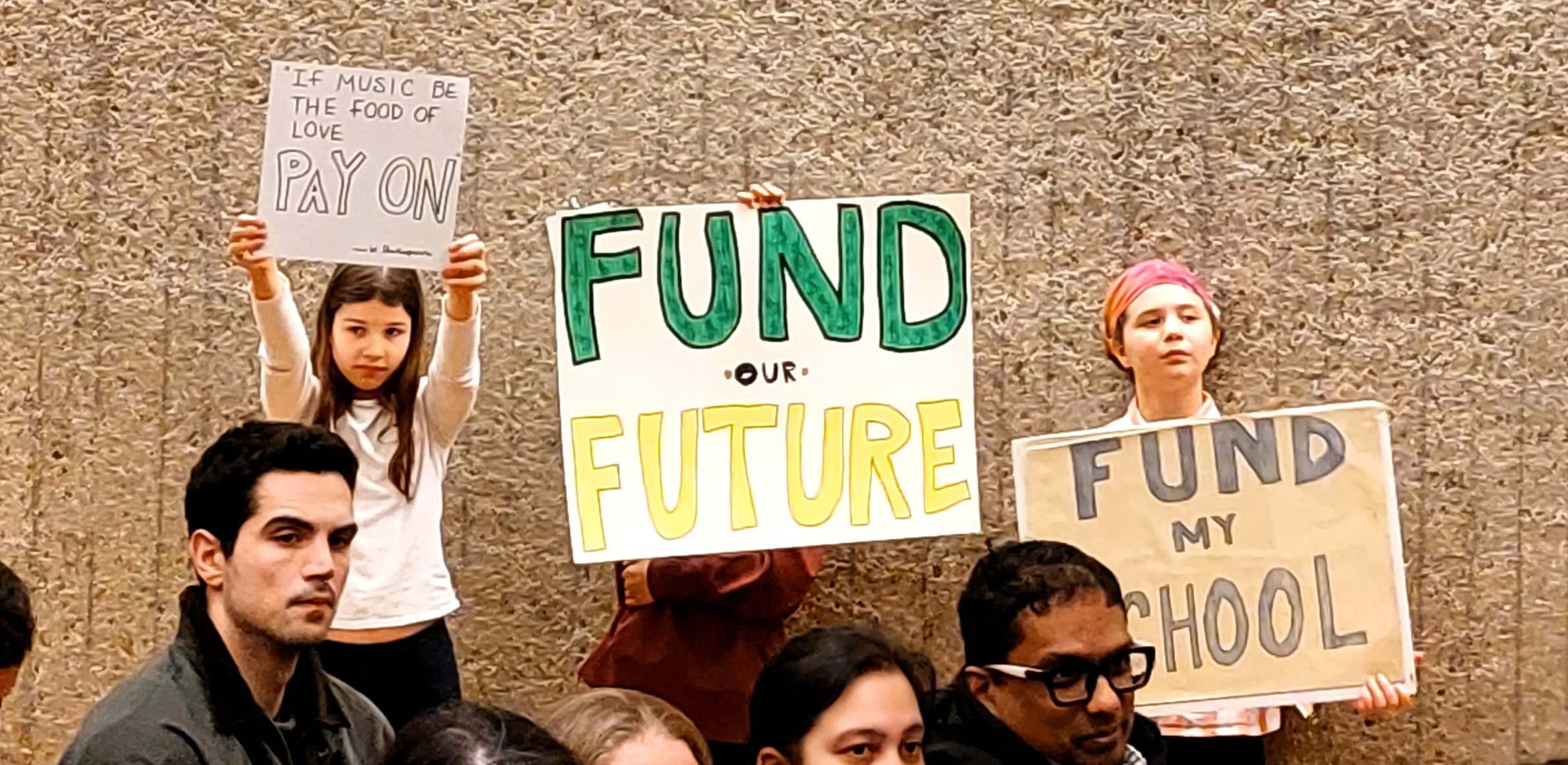Students hold signs at the March 24 Joint Ways & Means Committee hearing on school funding at the University of Massachusetts Amherst.
Reminder Publishing photo by Sarah Heinonen
AMHERST — The Healey administration’s education leadership was grilled by the Joint Ways & Means Committee in front of a standing room-only crowd at a hearing on school funding and local aid, hosted by the University of Massachusetts Amherst.
Among the groups of educators and students who came out to the March 24 meeting were those from Gateway Regional School District, Amherst Regional High School, Wachusett Regional School District, East Longmeadow Public Schools, Hampden-Wilbraham Regional School District and Southwick-Tolland-Granville Regional School District.
A large contingent of 25 students, staff and school committee members from Quabbin Regional School District attended the meeting. Superintendent Colleen Mucha said the students had been learning about how of being a rural, regional district impacts their education, and the practical considerations of education funding were “a valuable lesson.”
A Quabbin student shared with Reminder Publishing that when he began attending Quabbin Regional High School as a School Choice student, his father had a “drug addiction” and his mother was unemployed. “Quabbin had so many resources,” he said. He has joined the school’s Navy Junior Officer Training Corps and participated in two summer internships. “There’s so many people that care at Quabbin,” he said, which is why he is passionate about making sure the district can continue to provide for its students. He added, “Every kid deserves a good education, whether they’re in a city or a rural area.”
Many people in the audience held signs advocating for more funding, including ones that read, “Education is not just a word, it’s their future,” “Don’t balance the budget on the backs of our children” and “What are your accountability measures?”
Asked what she hoped her district’s presence would accomplish, STGRSD Superintendent Jennifer Willard said, “I would really like [the Joint Ways & Means Committee] to understand the needs of rural, regional school districts. Eight positions have had to be cut from her district to fund special education services.
The first panel of the six-hour hearing was composed of state Secretary of Education Patrick Tutwiler, Department of Elementary and Secondary Education acting Commissioner Russell Johnston, Commissioner of Higher Education is Noe Ortega and Department of Early Education and Care Amy Kershaw. Tutwiler told the audience of people advocating for funding, “I hear you. I see you.”
The panel participants made remarks highlighting the state’s accomplishments in education matters in fiscal year 2025 and planned for FY26. These included adding 17,000 preschool seats, funding $1.1 million for Childcare Financial Assistance Program to help families afford childcare, improve salaries for early childhood providers, and expand access and capacity through the Gateway to Pre-K program.
To benefit K-12 students, funding for universal meals was included in the proposed budget for a second year, early literacy funding was doubled and youth mental health is being addressed by cutting down on chronic absenteeism, so students will be able to access school-based resources.
Funding formulas
Turning to several of the issues that school districts have cited as major budgetary factors, Tutwiler said 95% of regional school transportation costs would be reimbursed by the state. While this is higher than in past years, under state law regional districts are supposed to be reimbursed “to the full extent of the amounts expended.”
Tutwiler said the state would be investing “the highest amount ever for special education Circuit Breaker funding” at $682 million. The Circuit Breaker is a reimbursement of up to 75% of special education costs incurred by district above an annually set threshold. This year that is $53,431 per pupil. The funding is received the year after the costs are incurred.
Chapter 70 is the largest source of state aid to schools. This year, 232 of the state’s 306 school districts are slated to receive an increase to their Chapter 70 funds of $75 per pupil. This is the minimum amount of funding, known as “hold harmless.” Last year, the amount was $104 per pupil.
Tutwiler said the state has fully funded the Chapter 70 increases “called for under the Student Opportunity Act,” which is legislation from 2019 that provides more funding to districts with large proportional populations of low-income other high needs students.
State Sen. Jake Oliveira (D-Ludlow) said that he had been fully supportive of the Student Opportunity Act, but said that at the time, “The Foundation Budget Review Commission’s report also said we shouldn’t wait another 30 years to crack open that funding formula. He acknowledged the gains made by “urban school districts and our gateway cities,” but the room erupted into thunderous applause as Oliveira told the state’s educational leadership, “The current Chapter 70 funding formula is not working for a majority of our schools.” Of the 11 school districts in Oliveira’s district, which spans from Belchertown to the Connecticut border and from Chicopee east to Warren, nine are facing multimillion shortfalls. With special education costs spiking year over year, Oliveira said the Circuit Breaker threshold must be lowered to capture the full extent of need.
State Rep. Meghan Kilcoyne (D-Clinton) said five of the six communities in her district were members of regional school districts. “The regional school districts in our state are struggling” with “challenges that are unique to rural communities across the state.” She said the costs are rising, particularly around special education and transportation, and the state is not keeping pace. She thanked the panel for reaching 95% reimbursement, while acknowledging that it is still shy of its commitment.
She said hold harmless is a “very important tool” to protect schools from declining enrollment eating into their funding, but “that means that they are capped at a certain rate that means that they can’t meet the rise in costs.” She said Wachusett lost 2% of its enrollment and still saw its cost increase by nearly 5%. She asked how the regional school districts can be supported. Tutwiler spoke about the “complexity” of school districts and said, “I understand the pain points of the funding issues” and “hear loud and clear about the challenges around special education and transportation costs.” He said the Healey administration used “a thoughtful approach” in distributing funding to different local aid funding mechanisms. He again cited the 24% increase in Circuit Breaker reimbursement and 95% reimbursement of regional transportation costs.
Committee co-chair and state Sen. Jo Comerford (D-Northampton) quoted aloud several news headlines that described job cuts in Belchertown, Amherst and South Hadley, as well as budget gaps of $400,000 or more in various towns. She said 75% of Chapter 70 aid is distributed to 56 school districts, just 18.3% of the state total. Like Oliveira, she said she supported the Student Opportunity Act, but said, “It has left us out.”
It has been 17 years since the last time the state reviewed the way it determines how much communities must pay toward providing a basic education, called a minimum local contribution. “Will you lead work to open up the Chapter 70 and municipal contribution formula?” Comerford asked Tutwiler.
The secretary responded, “We will follow the lead of the Legislature on this important conversation.” He said he could not guarantee that every issue cited would be addressed, but said the proposals in the governor’s budget would impact every school district in Massachusetts.
One state representative shared that the state Operational Services Division approved a tuition hike of $36,000 per student for a special education provider in his area, yet the CEO’s annual salary is $300,000 and the salary for the chief financial officer is $240,000 per year.
Johnston said providers receive multiple sources of revenue, not just funding from school districts. He explained that a special education provider can apply for a tuition increase every six years. To be approved the provider must demonstrate how the funding would serve a need, such as greater capacity for speech therapy students. The representative followed up by saying the services from this provider were inadequate. “From the cheap seats, it looks pretty bad,” he said.
Rural districts
State Rep. Todd Smola (R-Warren) said the many people on the committee, including him, “fought like hell” a few years ago to establish rural aid as a part of the state budget, but he was disappointed that it was level funded and “woefully inadequate.” this year.
“Our school systems and our communities are in trouble. This rural aid category has become a lifeline. We don’t have the same luxuries [as urban areas] of being in close proximity to resources in the rural part of the state, particularly in Western Massachusetts.” He said it should be a $60 million investment but only $16 million has been allocated.
Tutwiler said he was “very well aware of the reality of the experience that students have in those districts.” Rural aid was $4 million in 2022 and has quadrupled since then, he said, adding that other local aid categories will also benefit rural communities. “We looked at the whole picture, Mr. Representative, and the strategy that we employed is designed to address the main complex issues and I think we’ve done that.”
Vocational lottery
Several senators and representatives expressed concern about the proposal to admit students into vocational programs based on a lottery system.
State Rep. James Hawkins (D-Attleboro) said Bristol County Agricultural High School teaches students “to climb a tree with a chainsaw in their hand” and “use a backhoe, which normally, in the workforce would require a hoisting license. These are some programs that require significant responsibilities and safety requirements and does show the need for a selective admissions process.” He added that taking out-of-district students allows the school to continue its programming as there it receives a stipend for each of those students. He said a lottery, limited to in-district students, would cost the district $2.4 million.
Attleboro High School’s career technical education program has 19 separate areas of study, including dental care and banking. “Not everybody’s suited for that” he said, adding that the education would be “a waste” if the student did not have an interest in pursuing those careers. Ninety-five percent of students in Attleboro are enrolled in a CTE program. “I don’t see … how a lottery would do anything but wreck a well-greased wheel that’s working,” Hawkins said.
“Working for whom?” Tutwiler countered. “We are here for all of the students and what we’ve found…there are certain groups of students who don’t get access to these incredible programs.” He said a lottery would “break down barriers” and that in general, a student’s performance by age 12 determines whether they will be admitted into a vocational program. “I would hate to deny an opportunity to access something they’re really interested in based on a mistake that they made” when they were so young. Addressing Hawkins’s concerns, he said an “expression of interest” by the student is required.
As a last question, state Rep. Margaret Scarsdale (D-Pepperell) said each of her six districts are cutting at least 35 teachers, which will result in classes of as many as 40 students. While she acknowledged the multitude of factors, she urged Tutwiler to help the districts financially and long-term by addressing funding formulas. The secretary said, “We are more than willing to be close partners” but repeated that the governor’s administration would “follow the lead of the Legislature.”



